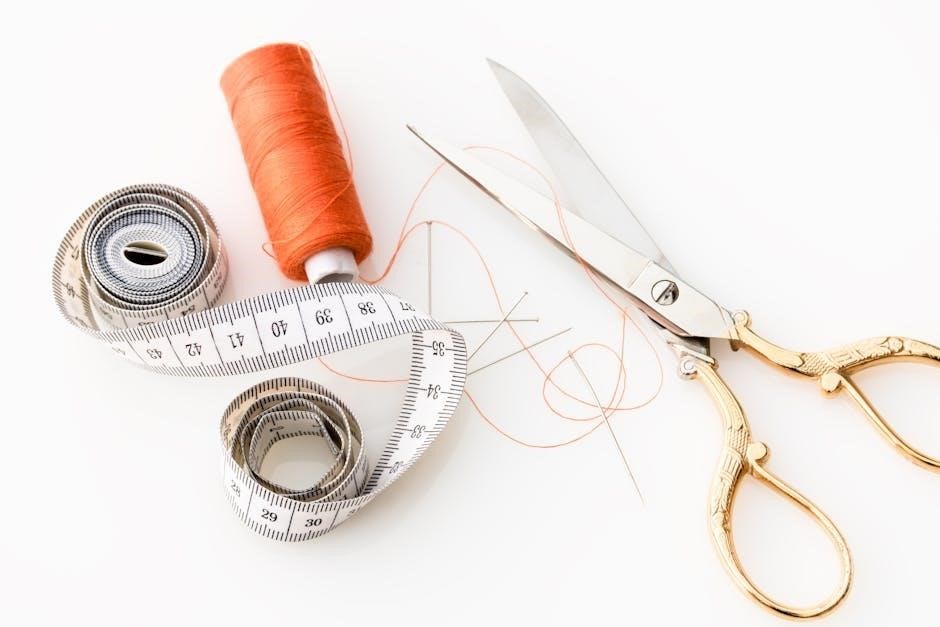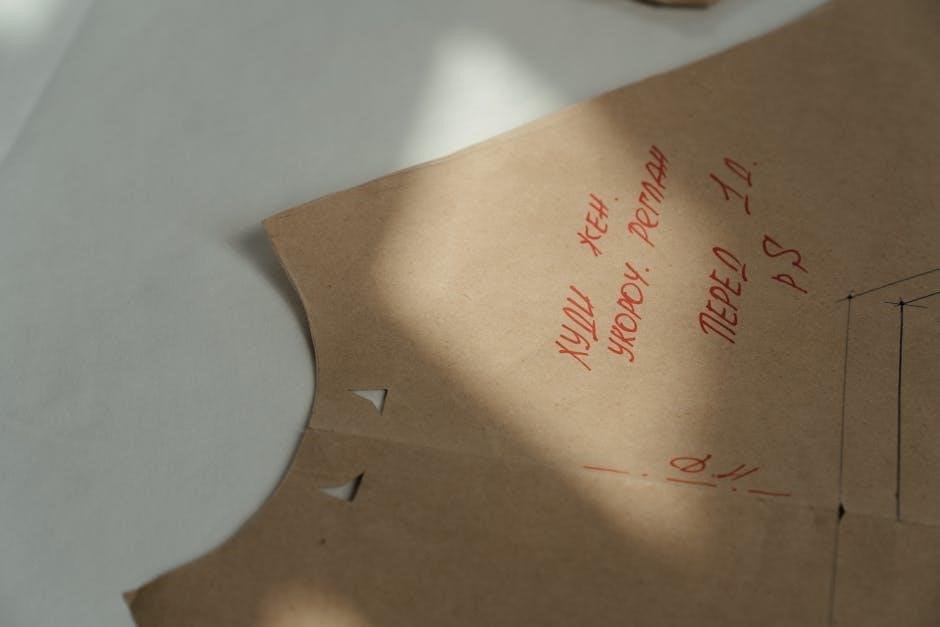reader’s digest complete guide to sewing
History of Sewing
The history of sewing dates back to ancient civilizations‚ with evidence of sewing tools and techniques found in Egypt‚ China‚ and Greece.
According to historical records‚ sewing was initially done by hand‚ with the use of needles‚ threads‚ and fabrics.
Over time‚ sewing evolved with the invention of the sewing machine in the 19th century‚ which revolutionized the textile industry.
The Readers Digest complete guide to sewing provides an overview of the history of sewing‚ from traditional hand-sewing techniques to modern machine sewing methods.
The guide also explores the impact of sewing on various cultures and societies‚ highlighting its significance in clothing‚ textiles‚ and craftsmanship.
By understanding the history of sewing‚ readers can appreciate the development of sewing techniques and technologies‚ and how they have shaped the sewing industry into what it is today.
The history of sewing is a fascinating topic that showcases human ingenuity and creativity‚ and its influence can still be seen in modern sewing practices.
Importance of Sewing in Daily Life
Sewing plays a significant role in daily life‚ providing individuals with a means to create‚ repair‚ and customize clothing and textiles.
The Readers Digest complete guide to sewing emphasizes the importance of sewing in daily life‚ from mending torn clothes to creating handmade gifts.
Sewing also promotes sustainability‚ as individuals can repurpose and reuse old fabrics‚ reducing waste and minimizing environmental impact.
Moreover‚ sewing can be a therapeutic activity‚ allowing individuals to express their creativity and relax.
The guide highlights the benefits of sewing‚ including developing fine motor skills‚ hand-eye coordination‚ and patience.
By incorporating sewing into daily life‚ individuals can develop a sense of accomplishment and pride in their creations‚ while also saving money and reducing reliance on fast fashion.
Overall‚ sewing is a valuable skill that can enrich daily life‚ providing a sense of fulfillment and creativity.
The importance of sewing in daily life is undeniable‚ and the Readers Digest guide provides a comprehensive resource for individuals to explore this versatile skill.

Types of Sewing

Readers Digest guide covers various sewing types‚ including decorative‚ embroidery‚ and quilting methods‚ with detailed steps and illustrations‚ making it easy to learn and master different sewing techniques always.
Hand Sewing
Hand sewing is a fundamental skill that requires patience and practice to master‚ with Readers Digest providing a comprehensive guide to hand sewing techniques and stitches‚ including the running stitch‚ backstitch‚ and slipstitch.
Hand sewing involves using a needle and thread to sew two pieces of fabric together‚ and is often used for repairs‚ alterations‚ and creating small items such as buttons and seams.
The guide covers various hand sewing tools and materials‚ such as needles‚ threads‚ and thimbles‚ and provides tips and tricks for achieving professional-looking results‚ making it a valuable resource for beginners and experienced sewers alike‚ with step-by-step instructions and illustrations to help learners understand the concepts easily and quickly‚ and start sewing with confidence‚ and with ease‚ every time.
Machine Sewing
Machine sewing is a faster and more efficient way of sewing‚ allowing users to complete projects quickly and accurately‚ with the Readers Digest guide providing an overview of machine sewing basics‚ including threading and operating a sewing machine.
The guide covers various machine sewing techniques‚ such as straight stitching‚ zigzag stitching‚ and backstitching‚ and provides tips for choosing the right machine and accessories‚ such as presser feet and needles‚ to achieve professional-looking results.
Machine sewing is ideal for large projects‚ such as garments and home decor items‚ and can be used for a variety of fabrics‚ including cotton‚ polyester‚ and silk‚ with the guide offering troubleshooting tips and maintenance advice to help users get the most out of their machine and complete their sewing projects with ease and confidence‚ every time‚ and with the help of online resources and tutorials‚ sewers can improve their skills and create beautiful and professional-looking items.

Sewing Tools and Equipment
Essential sewing tools include needles‚ threads‚ and scissors‚ with the Readers Digest guide providing a list of necessary equipment for beginners to start sewing with confidence and accuracy always.
Sewing Machines
Sewing machines are a crucial part of the sewing process‚ with various types available‚ including mechanical and computerized machines. The Readers Digest guide provides an overview of the different types of sewing machines‚ their features‚ and benefits. Sewing machines can be used for a variety of tasks‚ from simple repairs to complex sewing projects. They offer a range of stitch options‚ including straight stitch‚ zigzag stitch‚ and decorative stitches. When choosing a sewing machine‚ it is essential to consider factors such as the type of sewing to be done‚ the frequency of use‚ and the budget. The Readers Digest guide also provides tips on how to use and maintain a sewing machine‚ including how to thread the machine‚ wind the bobbin‚ and troubleshoot common problems. By following the guide‚ beginners can learn how to use a sewing machine with confidence and achieve professional-looking results. Sewing machines are a valuable investment for anyone who enjoys sewing.
Sewing Notions and Accessories
Sewing notions and accessories are essential components of the sewing process‚ providing the necessary tools to complete a project. The Readers Digest guide outlines the various types of notions and accessories available‚ including threads‚ zippers‚ buttons‚ and ribbons. Sewing notions and accessories can add a professional touch to a finished garment or project. They come in a range of colors‚ textures‚ and styles‚ allowing sewers to choose the perfect match for their project. The guide also provides tips on how to use and care for sewing notions and accessories‚ including how to store them and organize a sewing space. By having the right sewing notions and accessories on hand‚ sewers can ensure that their projects are completed efficiently and effectively. Sewing notions and accessories can be found at craft stores‚ online retailers‚ and specialty sewing shops‚ making it easy to stock up and stay prepared for any sewing project. They are a valuable addition to any sewing kit.

Sewing Techniques and Stitches
Mastering various sewing techniques and stitches is crucial for creating professional garments and home decor items with precision and accuracy always matters.
Basic Sewing Stitches
Learning basic sewing stitches is essential for beginners‚ and the Readers Digest complete guide to sewing provides a comprehensive overview of these fundamental stitches.
The guide includes step-by-step instructions and illustrations to help learners master the running stitch‚ backstitch‚ and slip stitch.
With practice‚ sewers can improve their skills and move on to more complex stitches‚ creating a wide range of garments and home decor items.
The guide also covers the importance of thread tension‚ needle selection‚ and fabric choice‚ all of which impact the quality of the finished product.
By following the guide and practicing regularly‚ beginners can develop the skills and confidence needed to tackle more challenging sewing projects.
The basic sewing stitches are the foundation of all sewing‚ and mastering them is crucial for creating professional-looking garments and home decor items with ease and precision always.
Advanced Sewing Techniques
Advanced sewing techniques are covered in the Readers Digest complete guide to sewing‚ including working with intricate fabrics and creating complex garments.
The guide provides detailed instructions on how to sew with silk‚ velvet‚ and other delicate materials‚ as well as how to create tailored suits‚ coats‚ and dresses.
It also covers advanced techniques such as embroidery‚ quilting‚ and applique‚ allowing sewers to add decorative elements to their projects.
With these advanced techniques‚ sewers can create professional-looking garments and home decor items that are both functional and beautiful.
The guide includes tips and tricks for working with different fabrics‚ threads‚ and notions‚ as well as troubleshooting common problems that may arise during the sewing process.
By mastering these advanced sewing techniques‚ sewers can take their skills to the next level and create stunning garments and home decor items with ease and precision always and confidently.
